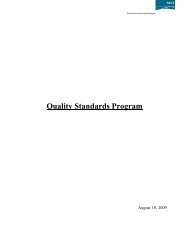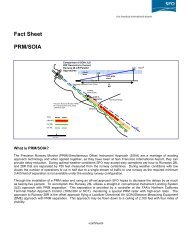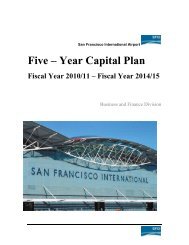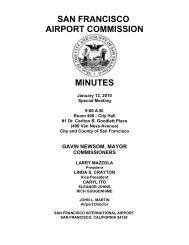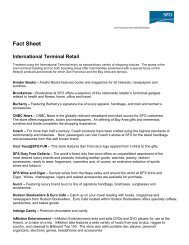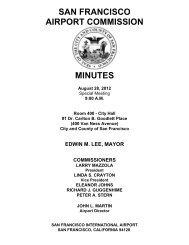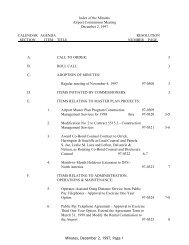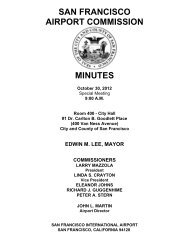Official Statement Airport Commission City and County of San ...
Official Statement Airport Commission City and County of San ...
Official Statement Airport Commission City and County of San ...
Create successful ePaper yourself
Turn your PDF publications into a flip-book with our unique Google optimized e-Paper software.
Certain <strong>of</strong> the airline maintenance, cargo <strong>and</strong> other facilities have been financed by bonds issued by the<br />
California Statewide Communities Development Authority, which has the authority to issue tax-exempt private<br />
activity bonds. These bonds are separately secured by leases or loans with the respective airlines <strong>and</strong> are not<br />
payable from Net Revenues. If United Airlines moved its maintenance operations from its Maintenance <strong>and</strong><br />
Operations Center <strong>and</strong> related facilities, United Airlines would remain responsible under the lease until the thencurrent<br />
expiration date.<br />
Seismic Design <strong>of</strong> <strong>Airport</strong> Facilities<br />
The <strong>Airport</strong> exists in a zone 4 seismic area. Seismic zones aid in identifying <strong>and</strong> characterizing certain<br />
geological conditions <strong>and</strong> the risk <strong>of</strong> seismic damage at a particular location <strong>and</strong> are used in establishing building<br />
codes to minimize seismic damage. The five seismic zones are: zone 0 (no measurable damage), zone 1<br />
(minor damage), zone 2 (moderate damage), zone 3 (major damage) <strong>and</strong> zone 4 (major damage <strong>and</strong> greater<br />
proximity than zone 3 to certain major fault systems).<br />
The ITC was designed to meet the structural <strong>and</strong> code requirements for a building <strong>of</strong> its type located in<br />
seismic zone 4 <strong>and</strong> to meet the st<strong>and</strong>ards <strong>of</strong> an “essential facility” (i.e., a facility that is immediately occupiable<br />
following a maximum credible seismic event). In addition, the more recent buildings <strong>and</strong> facilities constructed by<br />
the <strong>Airport</strong>, including the other terminal buildings, the AirTrain System <strong>and</strong> the <strong>Airport</strong>’s garages were designed to<br />
comply with then-current seismic design st<strong>and</strong>ards. These structures include the inbound <strong>and</strong> outbound freeway<br />
ramps <strong>and</strong> elevated circulation roadways serving the ITC; Garages A <strong>and</strong> G <strong>and</strong> the vehicle bridge connecting these<br />
two garages; Concourse H (the AirTrain/BART Station), the elevated guideway, eight stations, <strong>and</strong> the maintenance<br />
facility for the AirTrain system; the Rental Car Center; <strong>and</strong> the Communications Center located in a portion <strong>of</strong> the<br />
North Connector Building that links Terminal 2 to Terminal 3.<br />
In 2006, the <strong>Commission</strong> engaged an architectural firm to perform a feasibility study <strong>and</strong> seismic analysis<br />
<strong>of</strong> Terminal 2, which was constructed in 1951, <strong>and</strong> Boarding Area D <strong>and</strong> the FAA control tower, both <strong>of</strong> which are<br />
structurally integrated with Terminal 2 <strong>and</strong> were constructed in 1981. The analysis concluded that these facilities<br />
are highly susceptible to significant damage as a result <strong>of</strong> a major earthquake in the vicinity <strong>of</strong> the <strong>Airport</strong> which<br />
could render them inoperable for an extended period <strong>of</strong> time, <strong>and</strong> that they require significant structural upgrades in<br />
order to meet today’s stringent seismic code requirements <strong>and</strong> remain operable following a significant seismic event.<br />
The analysis also indicated that it is not cost effective nor operationally feasible to seismically upgrade the existing<br />
FAA control tower <strong>and</strong> that the FAA control tower should be relocated to a less seismically vulnerable site at the<br />
<strong>Airport</strong>.<br />
The <strong>Airport</strong> therefore is pursuing the construction <strong>of</strong> a replacement control tower in a new location with the<br />
FAA. The FAA has identified a preferred location for the new control tower, based on the results <strong>of</strong> their recent<br />
siting study. The <strong>Airport</strong> <strong>and</strong> the FAA are also discussing funding sources for the new control tower. In 2008,<br />
Congress appropriated an initial $1.5 million to the FAA to fund tower design activities at the <strong>Airport</strong>. The current<br />
Capital Plan provides for the renovation <strong>of</strong> Terminal 2 <strong>and</strong> Boarding Area D, including the required seismic<br />
upgrades for Boarding Area D. The Capital Plan also includes the anticipated FAA funding for the new control<br />
tower. The FAA has developed contingency plans for the operation <strong>of</strong> air traffic control functions from a temporary<br />
site in the event the FAA control tower is rendered inoperable. Such remote operations could result in a reduction in<br />
air traffic control service levels <strong>and</strong> capabilities, <strong>and</strong> may have a significant impact on the airspace system<br />
supporting the <strong>Airport</strong>. See also “CAPITAL PROJECTS AND PLANNING.”<br />
In April 2007, the <strong>Airport</strong> completed the first phase <strong>of</strong> a two phase project to install <strong>and</strong> construct<br />
improvements to the upper level roadway at the domestic terminals to increase seismic stability. The first phase <strong>of</strong><br />
the improvements consisted <strong>of</strong> seismically retr<strong>of</strong>itting the upper level viaduct adjacent to Terminals 1 <strong>and</strong> 2,<br />
installation <strong>and</strong> construction <strong>of</strong> related improvements, utilities <strong>and</strong> lighting systems. In September 2008, the <strong>Airport</strong><br />
received authorization from the State to proceed with the second <strong>and</strong> final phase <strong>of</strong> this project, which is located<br />
adjacent to Terminal 3. The contract for this project was awarded <strong>and</strong> construction commenced in March 2009.<br />
Completion <strong>of</strong> this project is expected in December 2010. In addition, the <strong>Airport</strong> maintains contingency plans to<br />
deal with major seismic events. See also, “CERTAIN RISK FACTORS–Seismic Risks.”<br />
41



